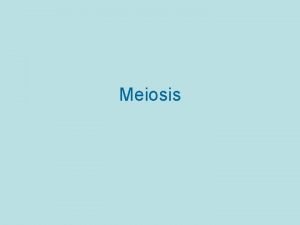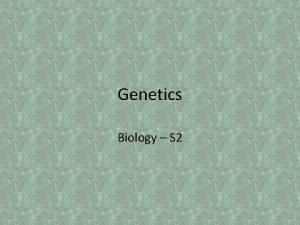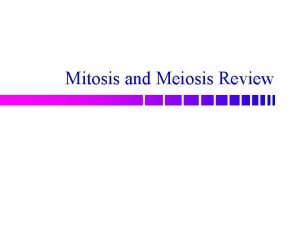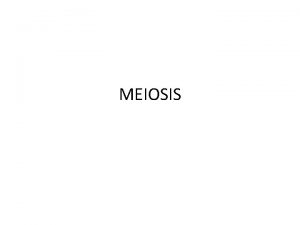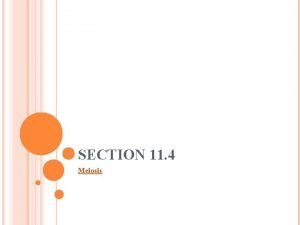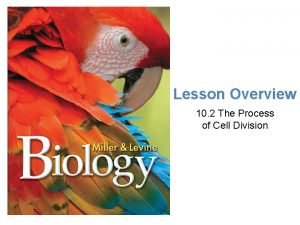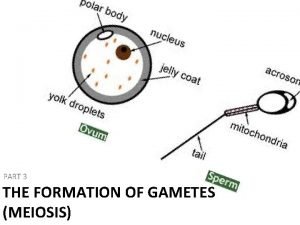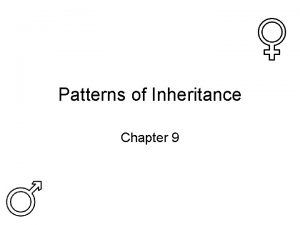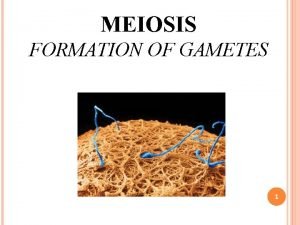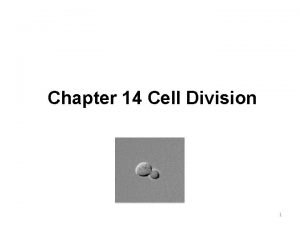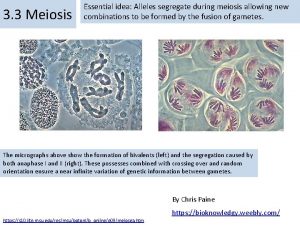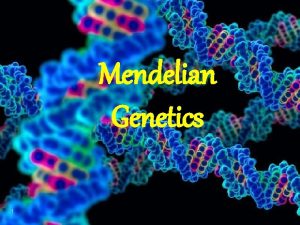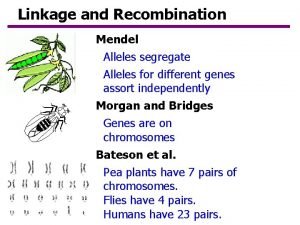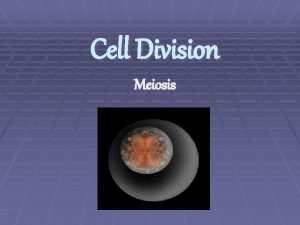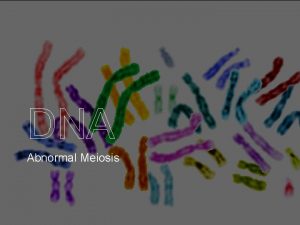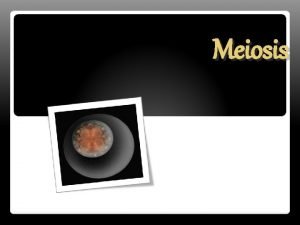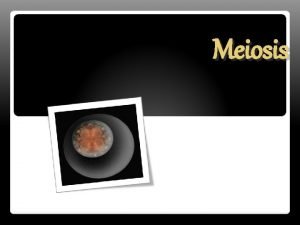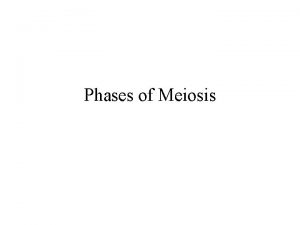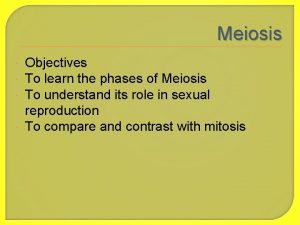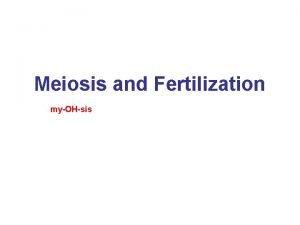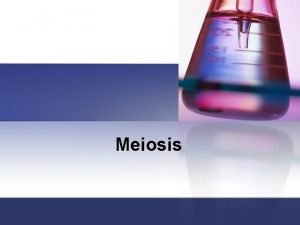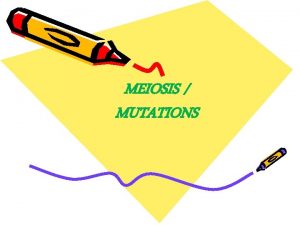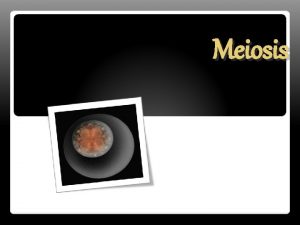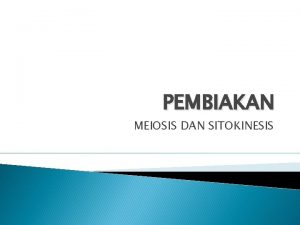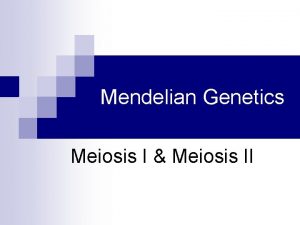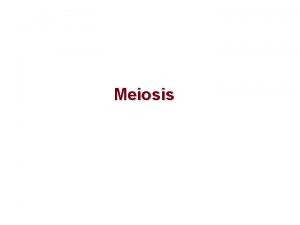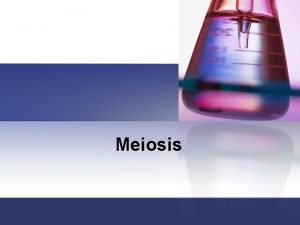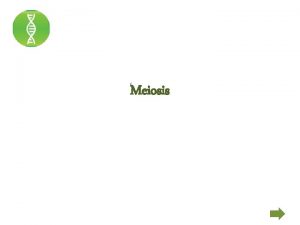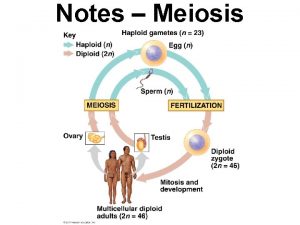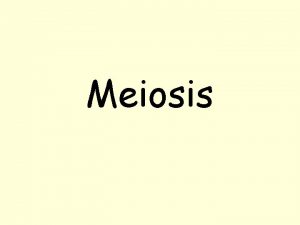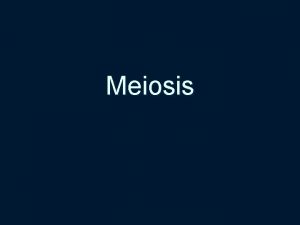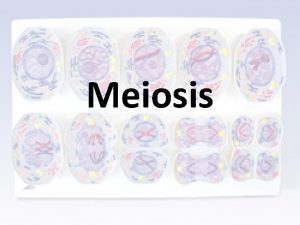What occurs during the phases of meiosis Sections


























- Slides: 26

+ What occurs during the phases of meiosis? Sections 8. 1 2 to 8. 18

+ Homologous Chromosomes n Somatic Cell n Body cells n All cells excepts the sperm and the egg (gametes/sex cells) n Chromosome Number for Humans n 46 n 23 pair n Homologous Chromosomes n 2 chromosomes that are the same length, shape, centromere position and code for the same genetic information n 1 from each parent

Fig. 13 -3 b +TECHNIQUE Pair of homologous replicated chromosomes Centromere Sister chromatids Metaphase chromosome 5 µm

+ Autosome vs. Sex Chromosome n n Autosomes n Chromosomes that are the same in males and females n Pairs 1 through 22 on a karyotype Sex Chromosomes n Chromosomes that are different in males and females n Chromosomes that determine sex n Pair 23 on a karyotype n Female – XX n Male XY

+ Diploid vs. Haploid n Diploid n Cells that have 2 sets of genetic information n 2 sets of homologous chromosomes n Designated by “ 2 n” n In humans 2 n= 46 n Normal body cells n Haploid n Cells that have 1 set of genetic information n Only one of each homolog n Designated by “n” n In humans n=23 n Gametes

+ Gametes vs. Zygote n n Gametes n Sex Cells n Sperm or Egg n Haploid Zygote n Fertilized egg n Diploid

+ Meiosis • Gamete formation • Like mitosis, meiosis is preceded by the replication of chromosomes • Meiosis takes place in two sets of cell divisions, called meiosis I and meiosis II • The two cell divisions result in four daughter cells, rather than the two daughter cells in mitosis – also called Reduction Division (MI = reduction / MII = division) • Each daughter cell has only half as many chromosomes as the parent cell – starts with “ 2 n” cell ends with four “n” cells


+ Prophase I n Nuclear membrane breaks down n Nucleolus disappears n Chromatin condenses into chromosomes n Synapsis occurs n n Homologous chromosomes come together (forming a tetrad) Crossing over can occur

+ Metaphase I n Homologous pairs line up at the metaphase plate n Spindle fibers attach to the kinetechores

+ Anaphase I n Homologous chromosomes are pulled apart n Note: centromeres DO NOT split

+ Telophase I and Cytokinesis n Double chromosomes are at the poles n Nuclear membrane reforms n Nucleolus reappears n Cytoplasm Separates n Note: at this point there are 2 genetically unique haploid cells - REDUCTION

+ Prophase II n Nuclear membrane breaks down n Nucleolus disappears n Chromatin condenses to chromosomes n Note: no synapsis n Note: haploid

+ Metaphase II n Chromosomes move to the metaphase plate n Note: single file like mitosis except these cells are haploid

+ Anaphase II n Sister chromatids pulled apart n Note: centromere splits just like anaphase of mitosis only with haploid cells

+ Telophase II and Cytokinesis n Chromosomes are at the poles n Nuclear membrane reforms n Cytoplasm divides n Note: produces 4 genetically unique haploid cells

+ Gamete formation in Animals

+ Gamete formation in Plants

+ How does meiosis differ from mitosis?

Fig. 13 -9 a + MITOSIS MEIOSIS Parent cell Chromosome replication Prophase Chiasma Chromosome replication Prophase I Homologous chromosome pair 2 n = 6 Replicated chromosome MEIOSIS I Metaphase I Anaphase Telophase Anaphase I Telophase I Haploid n=3 Daughter cells of meiosis I 2 n Daughter cells of mitosis 2 n MEIOSIS II n n Daughter cells of meiosis II

Fig. 13 -9 b + Mitosis vs. Meiosis SUMMARY Property Mitosis Meiosis DNA replication Occurs during interphase before mitosis begins Occurs during interphase before meiosis I begins Number of divisions One, including prophase, metaphase, and telophase Two, each including prophase, metaphase, and telophase Synapsis of homologous chromosomes Does not occur Occurs during prophase I along with crossing over between nonsister chromatids; resulting chiasmata hold pairs together due to sister chromatid cohesion Number of daughter cells and genetic composition Two, each diploid (2 n) and genetically identical to the parent cell Four, each haploid (n), containing half as many chromosomes as the parent cell; genetically different from the parent cell and from each other Role in the animal body Enables multicellular adult to arise from zygote; produces cells for growth, repair, and, in some species, asexual reproduction Produces gametes; reduces number of chromosomes by half and introduces genetic variability among the gametes

+ Independent Assortment of Chromosomes • Homologous pairs of chromosomes orient randomly at metaphase I of meiosis • In independent assortment, each pair of chromosomes sorts maternal and paternal homologues into daughter cells independently of the other pairs Copyright © 2008 Pearson Education Inc. , publishing as Pearson Benjamin Cummings

Fig. 13 -11 -3 + Possibility 2 Possibility 1 Two equally probable arrangements of chromosomes at metaphase I Metaphase II Daughter cells Combination 1 Combination 2 Combination 3 Combination 4

+ Crossing Over • Crossing over produces recombinant chromosomes, which combine genes inherited from each parent • In crossing over, homologous portions of two nonsister chromatids trade places • Crossing over contributes to genetic variation by combining DNA from two parents into a single chromosome

Fig. 13 -12 -5 + Prophase I of meiosis Pair of homologs Nonsister chromatids held together during synapsis Chiasma Centromere TEM Anaphase II Daughter cells Recombinant chromosomes

+ Chiasma n The microscopically visible site where crossing over has occurred between chromatids of homologous chromosomes during prophase I
 Metaphase
Metaphase Phases of meiosis
Phases of meiosis Phases of meiosis
Phases of meiosis Meiosis has 8 main phases true or false
Meiosis has 8 main phases true or false Meiosis 1 stages
Meiosis 1 stages Meiosis and genetic variation usatestprep
Meiosis and genetic variation usatestprep Prohase 2
Prohase 2 Differentiate between chromosome and chromatid
Differentiate between chromosome and chromatid Chapter 10 section 1 meiosis
Chapter 10 section 1 meiosis Meiosis 1
Meiosis 1 Chapter 10 section 10.2 meiosis worksheet answer key
Chapter 10 section 10.2 meiosis worksheet answer key Crossing-over occurs during
Crossing-over occurs during Plant cell division
Plant cell division Mitosis and meiosis
Mitosis and meiosis Crossing-over occurs during
Crossing-over occurs during Proofreading and repair of a dna strand occurs during:
Proofreading and repair of a dna strand occurs during: Telophase 2 and cytokinesis
Telophase 2 and cytokinesis Chromosome duplication occurs during
Chromosome duplication occurs during Predict what would happen if cytokinesis was skipped
Predict what would happen if cytokinesis was skipped During ____ phases more of the moon is visible each night
During ____ phases more of the moon is visible each night When do alleles segregate during meiosis
When do alleles segregate during meiosis How many divisions take place during meiosis? *
How many divisions take place during meiosis? * When do alleles segregate during meiosis
When do alleles segregate during meiosis Parental vs recombinant
Parental vs recombinant Dạng đột biến một nhiễm là
Dạng đột biến một nhiễm là Vẽ hình chiếu đứng bằng cạnh của vật thể
Vẽ hình chiếu đứng bằng cạnh của vật thể
